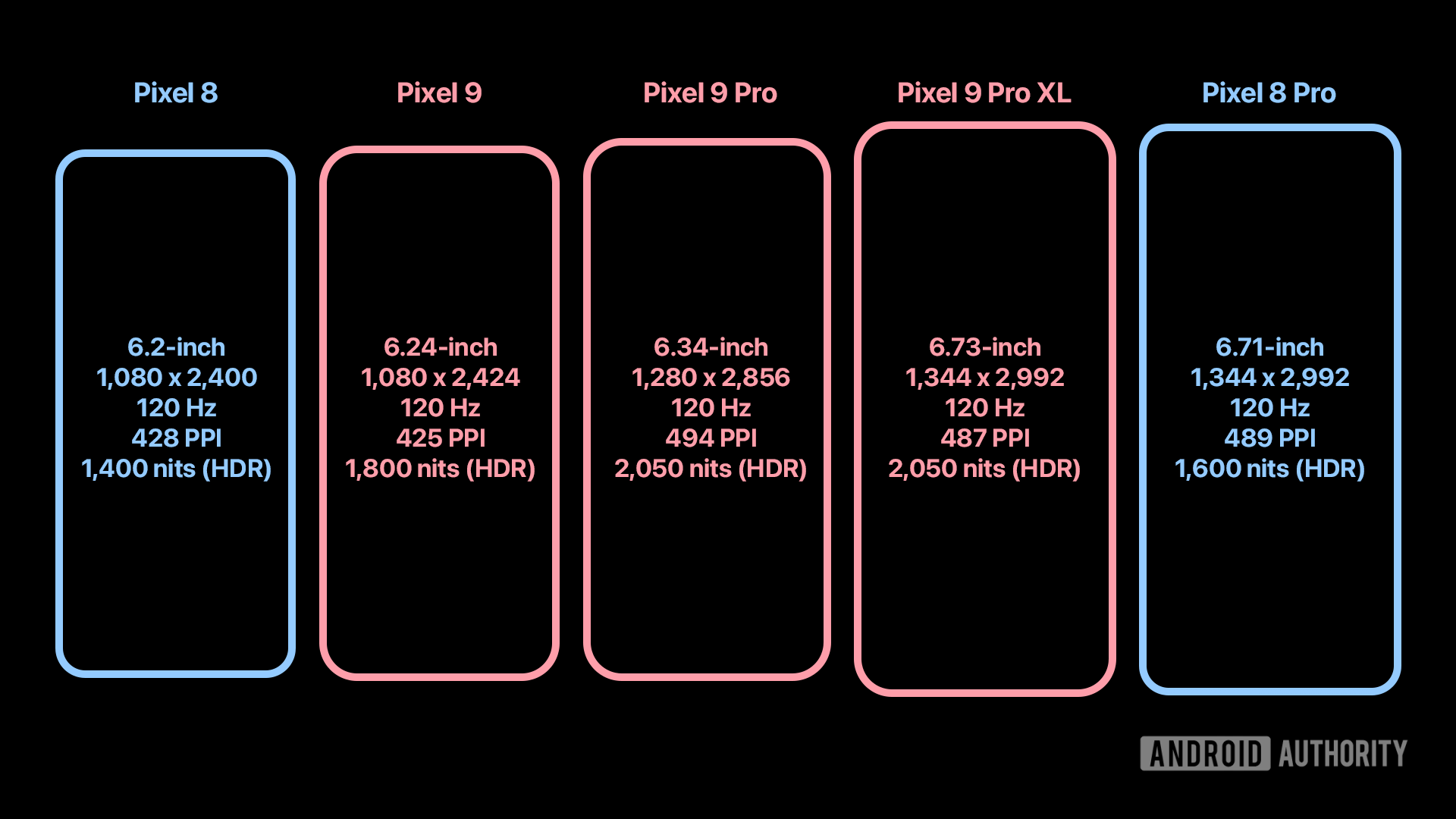Affiliate links on Android Authority may earn us a commission. Learn more.
Exclusive: Google Pixel 9 series' displays to be serious competition for the Galaxy S24
Published onJuly 24, 2024
The Google Pixel 9 series is set to bring some great upgrades; there’s new camera hardware, an ultrasonic fingerprint reader, and a lot more. Another rumor we’ve seen recently is that Google’s upcoming phones will include displays based on Samsung’s M14 OLED technology, potentially making them some of the best phones on the market in terms of display quality.
Now, thanks to a source inside Google, we’re able to preview these upcoming display changes coming to the Pixel 9 series.
Boosting brightness across the board

Rumor has it that the new Pixel 9 series will include a display based on the Samsung M14 material. OLED technology is constantly evolving, with manufacturers introducing new materials, and M14 is Samsung’s newest iteration. As reported by ET News, M14 will provide better brightness and longevity. The new panel is coming to the Pixel 9 series as well as the iPhone 16 Pro, while the current-gen Samsung Galaxy S24 uses the last-generation M13.
But what does that mean in practice? Well, much brighter displays for a start. The Pixel 8 series was already a huge step forward in that respect, bumping the Pixel 8 and 8 Pro’s HDR full-screen brightness to 1,400 and 1,600 nits, respectively. The Pixel 9 series goes even further.
New Samsung M14 OLED panels would make the Pixel 9 one of the brightest devices on the market.
The base Pixel 9 is receiving a new 1,800-nit display, besting Google’s previous-generation flagship. Not only that, but both of the (non-folding) Pro Pixels are getting an eye-popping upgrade to 2,050-nit displays, which should make them some of the brightest phones on the market. Google provides HDR values for full-screen brightness, so localized peak brightness values will be even higher.
We can also confirm the regular Pro Pixel will come with a display that’s closer in size to the regular Pixel 9 than the Pixel 9 Pro XL, measuring 6.34 inches. That’s good news if you’ve been holding out for a more compact premium flagship model. Other than that, the new Pixels’ display specs are pretty similar to those of their predecessors. The pixel-per-inch values are similar, the panels still support up to 120Hz refresh rates, the resolutions are basically identical, and the corner radius is only slightly larger.
I’ve compiled all the display specs in the table below, along with those of their respective predecessors, for a side-by-side comparison.
| Pixel 8 | Pixel 9 | Pixel 9 Pro | Pixel 9 Pro XL | Pixel 8 Pro | |
|---|---|---|---|---|---|
Size | Pixel 8 6.2-inch (64x143mm) | Pixel 9 6.24-inch (64x145mm) | Pixel 9 Pro 6.34-inch (66x147mm) | Pixel 9 Pro XL 6.73-inch (70x155mm) | Pixel 8 Pro 6.71-inch (70x155mm) |
Resolution | Pixel 8 1,080 x 2,400 | Pixel 9 1,080 x 2,424 | Pixel 9 Pro 1,280 x 2,856 | Pixel 9 Pro XL 1,344 x 2,992 | Pixel 8 Pro 1,344 x 2,992 |
Refresh rate | Pixel 8 120 Hz | Pixel 9 120 Hz | Pixel 9 Pro 120 Hz | Pixel 9 Pro XL 120 Hz | Pixel 8 Pro 120 Hz |
PPI | Pixel 8 428 | Pixel 9 425 | Pixel 9 Pro 494 | Pixel 9 Pro XL 487 | Pixel 8 Pro 489 |
HDR brightness (declared) | Pixel 8 1,400 nits | Pixel 9 1,800 nits | Pixel 9 Pro 2,050 nits | Pixel 9 Pro XL 2,050 nits | Pixel 8 Pro 1,600 nits |
Software corner radius | Pixel 8 102 px | Pixel 9 132 px | Pixel 9 Pro 157 px | Pixel 9 Pro XL 153 px | Pixel 8 Pro 115 px |
What do you think about the display upgrades coming to the Pixel 9 series? Let us know below.